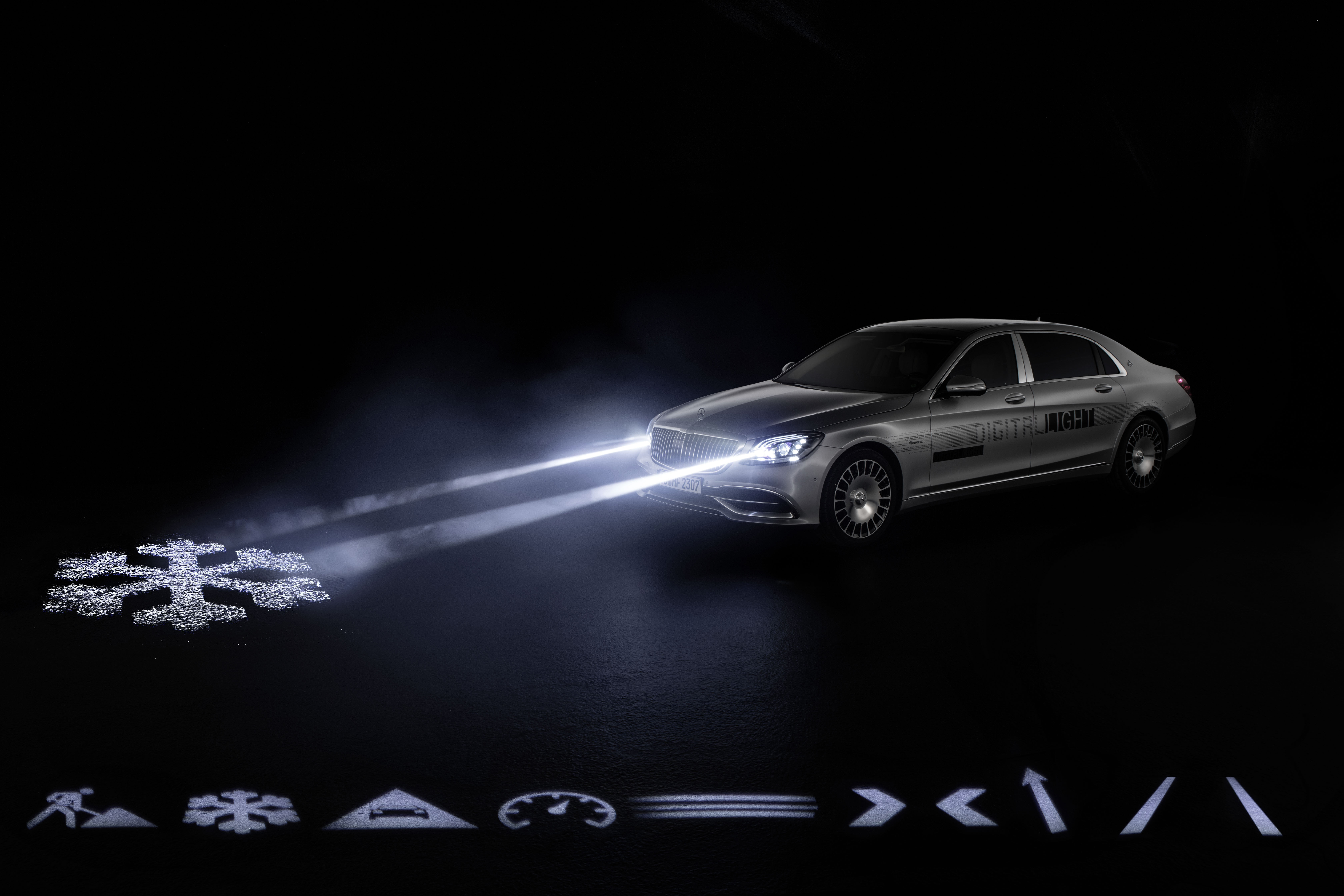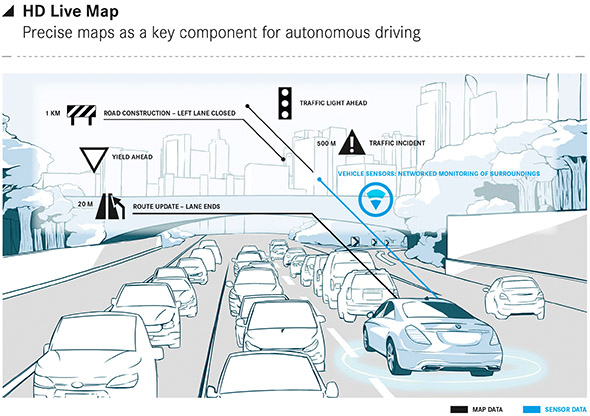In detail: how the spotlight function actually works
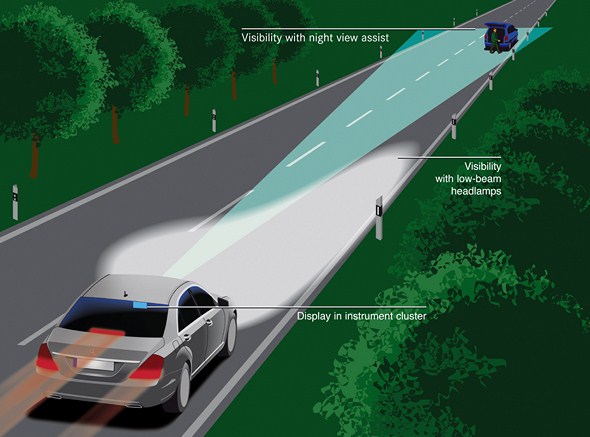

Caution, pedestrian on the road!
The Night View Assist Plus with new spotlight function is a complex combination of a variety of technical functions.
Infrared headlamps, night vision camera, multipurpose camera, spotlight headlamps, instrument cluster display and headlamp switch are all coordinated by several control units using complex software.
This is how the innovative safety feature works in detail: the spotlight function is enabled when the driver switches on Adaptive Highbeam Assist as normal (by turning the rotary light switch to the “Auto” position and pushing the steering-column stalk forward into the main beam position) and activates Active Night View Assist Plus by pressing the adjacent button.
The spotlight function is then enabled at speeds above 45 km/h. A corresponding icon in the night vision image notifies the driver that the spotlight function is switched on/active.
At speeds below 40 km/h, the spotlight function is automatically disabled.
The driver can also disable the function at will, by moving the steering-column stalk from the main beam position into the centre, neutral position (the usual procedure for dimming the lights).
The spotlight function uses infrared technology to detect pedestrians at a range of up to 80 metres: two separate light sources in the headlamps illuminate the road with invisible, non-dazzling infrared light.
A windscreen-mounted camera designed to pick up precisely this type of light records what happens in front of the car.
The captured image is sent to a display in the instrument cluster. The clear, needle-sharp image that appears here shows the scene in front of the vehicle, allowing the driver to see pedestrians, cyclists or obstacles on the road at an early stage.
As soon as the system detects any pedestrians in front of the car, they are highlighted in the display by the Active Night View Assist Plus.

A second camera, also used as a so-called multipurpose camera by the Speed Limit Assist and Lane Keeping Assist, detects whether the vehicle is being driven at night.
It also records the position of other road users travelling in front or approaching from the opposite direction.
All of this information is used by the electronic control unit to decide whether a detected pedestrian is to be flashed with the spotlight function as a warning.
For variable light distribution, a groove cut into the profile of the headlamps helps to create a controllable light source, the spotlight.
Outside of built-up areas, pedestrians are flashed with the spotlight function up to four times at night, provided they are located within the light cone.
If the Adaptive Highbeam Assist has been switched to dipped beam, the pedestrian is flashed with the spotlight function beyond the area of the dipped beam.
If on the other hand main beam is activated, this remains on in the left-hand headlamp, while the pedestrian is flashed with the right-hand headlamp.
The flashing headlamp then remains dipped for five seconds in order to avoid dazzling the pedestrian during this time.
It is not possible for other road users to be dazzled, since illumination does not occur when other vehicles which are travelling in front or approaching from the opposite direction are located in the same direction as the pedestrian.
In addition, the driver can also disable the spotlight function at any time should he so wish using the steering column stalk.
If the pedestrian should disappear from the camera image, for example because the vehicle has already passed him by or he has moved away from the edge of the road, the headlamp returns to full beam again before the five-second period expires, provided that the conditions imposed by the Adaptive Highbeam Assist have been met.
This helps to ensure that the driver once again has access to the full main beam function, and therefore the best road illumination, as quickly as possible.
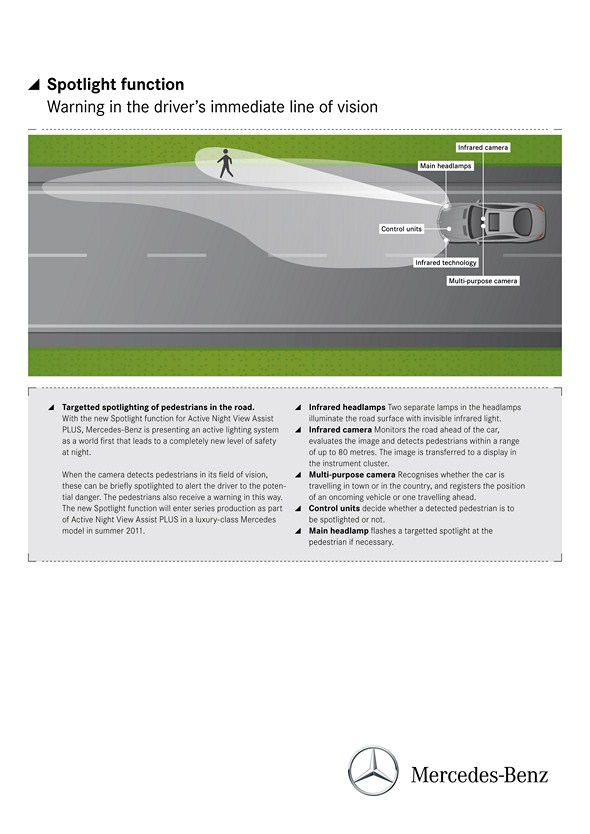
Review
Milestones in lighting technology
Avoiding accidents and mitigating their consequences: this is what Mercedes-Benz’s comprehensive safety philosophy is all about.
Achieving optimum visibility as well as being seen in time play a very significant role in this area.
A lot of the improvements made to active safety by Mercedes-Benz have come about as a result of the company combining innovative light technology with the latest assistance systems.
And other road users often benefit from such measures too.
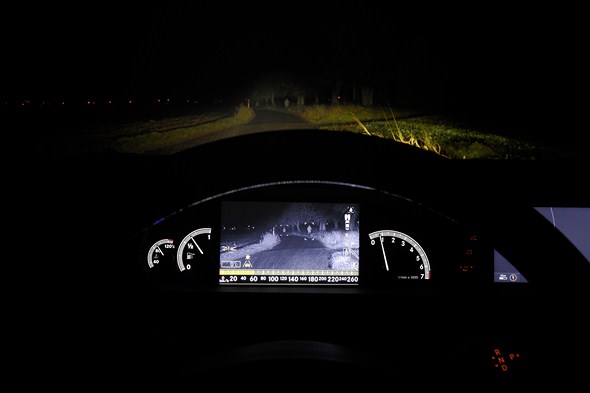
For example, Adaptive Highbeam Assist, which was presented in the E-Class in 2009, helps to prevent the drivers of oncoming vehicles and also vehicles travelling in front from being dazzled.
Mercedes-Benz has always stood for innovations aimed at improving customer benefits. Many of the innovations find their way into volume-produced model series after starting life in research vehicles, such as the ESF 2009, and also via innovation carriers such as the CL and S-Class.
Xenon light, for example, has in the meantime become available for all Mer cedes-Benz model series and on average has a specification rate of over 55 percent.
A similar success story has been enjoyed with the Active Night View Assist: currently more than half of S-Class models are ordered with this feature worldwide.
And when it comes to the unique LED High Performance headlamps on the new CLS, the market researchers at Mercedes are predicting a specification rate of more than 80 percent.
Here is a brief chronology of the most important milestones in Mercedes-Benz light technology over the past 20 years:
1991: premiere of xenon headlamps with gas discharge lamps in the Mercedes F 100 research vehicle
1995: xenon headlamps with dynamic headlamp range control in the Mercedes-Benz E-Class
1999: premiere of bi-xenon technology in the Mercedes-Benz CL-Class
2003: world premiere of the active light function in the Mercedes-Benz E-Class
2004: world premiere of bi-xenon headlamps with the active light function and cornering lights in the Mercedes-Benz CLS
2005: premiere of the Active Night View Assist in the Mercedes-Benz S-Class
2006: world premiere of the Intelligent Light System in the E-Class
2009: world premiere of the Intelligent Light System with Adaptive Highbeam Assist in the E-Class
2009: premiere of the Active Night View Assist Plus in the Mercedes-Benz S and E-Class
2010: world premiere of the LED High Performance headlamps with all of the light functions of the Intelligent Light System in the Mercedes CLS
2010: new xenon burners with a 20 percent higher colour temperature, and therefore closer to daylight, in the S and E-Class
2010: world premiere of the spotlight function (in series production from 2011)



